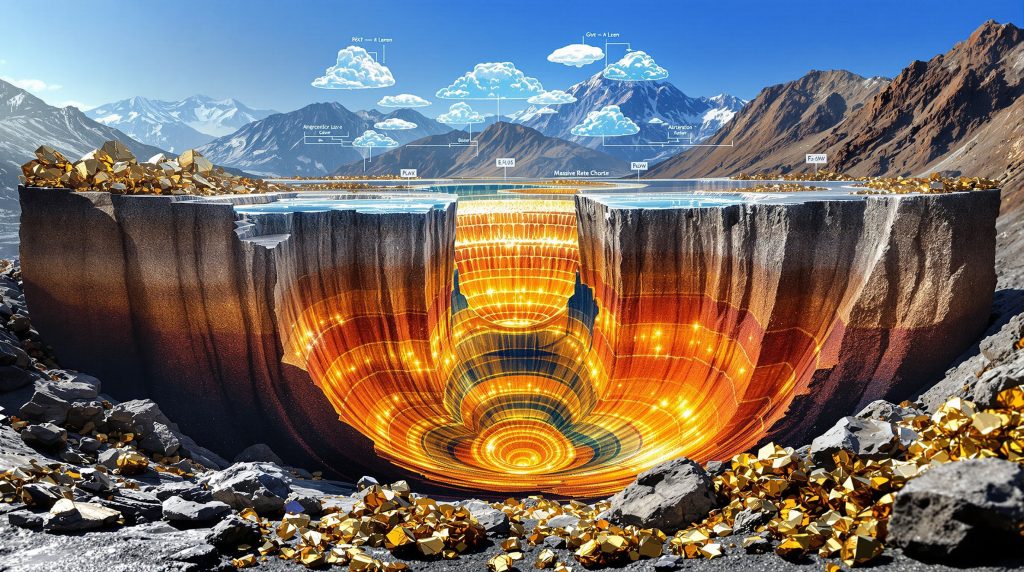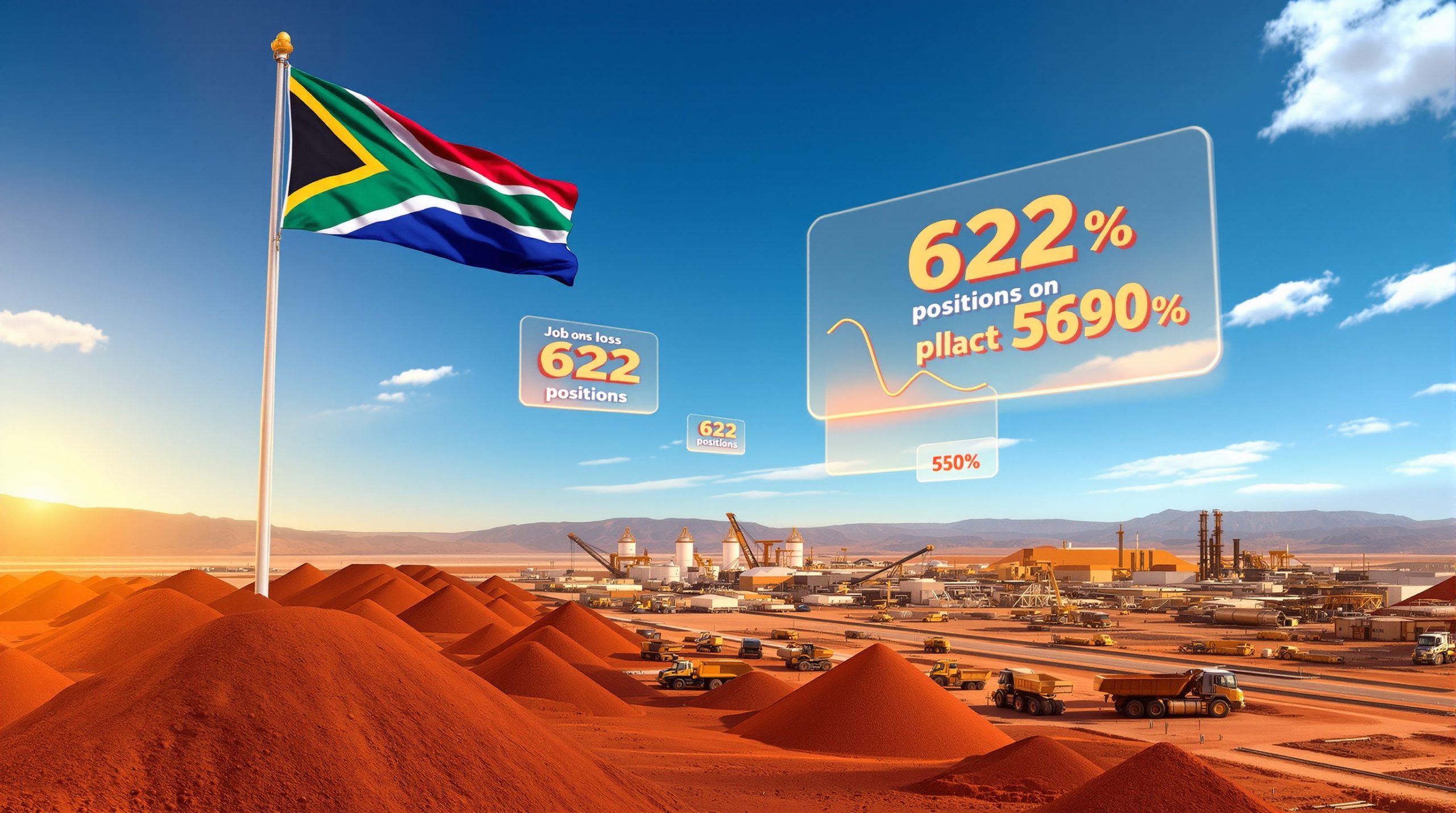What Are Porphyry Copper-Gold Deposits?
Porphyry copper-gold deposits rank among the planet's most economically significant mineral systems. These massive formations serve as the backbone of global copper production and contribute substantially to gold supplies worldwide. What makes these deposits distinctive is their enormous size combined with their characteristic mineralization patterns.
These deposits develop when metal-enriched magmatic fluids circulate through extensive networks of fractured rock, gradually depositing copper, gold, and other valuable metals. The resulting mineralization spreads through vast volumes of crustal material, creating economically viable concentrations despite relatively low metal grades.
Key Characteristics of Porphyry Systems
Porphyry deposits exhibit several defining features that distinguish them from other mineral deposit tiers:
- Immense scale: Typically spanning several kilometers across and extending to considerable depths
- Grade distribution: Generally contain lower metal concentrations (0.3-1% copper, 0.1-1.5 g/t gold) distributed throughout enormous volumes of rock
- Distinctive texture: Associated with porphyritic intrusions characterized by large, well-formed crystals (phenocrysts) set within a fine-grained groundmass
- Economic significance: Provide approximately 60-70% of global copper production and significant gold output
- Operational longevity: Support mining operations lasting decades, with some mines like Bingham Canyon operating continuously for over a century
Geological Significance
These remarkable systems represent the culmination of complex magmatic-hydrothermal processes that effectively concentrate metals from deep crustal sources. Their formation involves multiple intrusive events, extensive fluid circulation systems, and precise mineral precipitation mechanisms.
The resulting deposits display distinctive zonation patterns, with concentric rings of alteration minerals providing valuable clues about formation conditions and potential economic value. This systematic arrangement of minerals serves as a critical exploration guide for geologists seeking new ore bodies.
Why Do Porphyry Deposits Form in Subduction Zones?
Porphyry copper-gold deposits show a striking spatial relationship with convergent plate boundaries. This distribution is no coincidence—the unique geological conditions created by subduction zones provide the perfect environment for porphyry formation.
Tectonic Setting and Metal Sources
The vast majority of economic porphyry systems develop in regions where oceanic crust subducts beneath continental or island arc lithosphere. This tectonic configuration creates several critical conditions:
- Magma generation: As the subducting oceanic plate descends into the mantle, it releases water and other volatiles. These fluids lower the melting point of the overlying mantle wedge, generating metal-enriched magmas
- Structural pathways: The compression and deformation associated with convergent margins create extensive fracture networks that provide pathways for magma ascent
- Metal enrichment processes: Subduction effectively concentrates copper, gold, and other metals in the rising magmas through complex geochemical processes
- Volatile accumulation: The high water and volatile content in subduction-related magmas proves essential for efficient metal transport
Magmatic Arc Development
The formation of magmatic arcs above subduction zones creates particularly fertile grounds for porphyry development:
- Continental arcs (exemplified by the Andes) host many of the world's largest copper-gold porphyry systems, benefiting from thick continental crust and prolonged magmatic activity
- Island arcs (such as those in Papua New Guinea and the Philippines) contain significant porphyry deposits with distinctive characteristics related to their oceanic foundation
- Post-collisional and extensional settings can also support porphyry formation under specific conditions, though these deposits often show different metal assemblages
The subduction process effectively serves as a giant metal concentrator, extracting metals from oceanic crust and focusing them into the overlying magmatic systems where porphyry deposits form.
What Is the Step-by-Step Formation Process?
The journey from ordinary rock to valuable porphyry copper-gold deposit involves a remarkable sequence of geological processes. Understanding this formation pathway helps explorers identify new deposits and miners optimize extraction methods.
Stage 1: Magma Generation and Ascent
The story begins in the depths of Earth's mantle:
- Dehydration reactions in the subducting oceanic slab release water, carbon dioxide, and other volatiles into the overlying mantle wedge
- These fluids dramatically lower the melting point of mantle material, generating hydrous, metal-enriched magmas
- The buoyant magmas rise through the crust, forming magma chambers at depths typically ranging from 5-15 kilometers
- Multiple pulses of magma may intrude the same area over thousands to millions of years, building complex, multi-phase intrusive systems
Stage 2: Magma Evolution and Crystallization
As magma accumulates in crustal chambers, several critical processes unfold:
- Slow cooling allows large crystals (phenocrysts) of feldspars, quartz, and biotite to form within the magma
- Continued crystallization effectively concentrates remaining volatiles and metals in the residual melt, as these elements prefer to remain in the liquid phase
- Pressure gradually builds within the chamber as volatile content increases
- The distinctive porphyritic texture develops, with large crystals suspended in a finer groundmass that crystallizes during the final cooling stage
This two-stage cooling history creates the characteristic porphyritic texture that gives these deposits their name.
Stage 3: Hydrothermal Fluid Exsolution
The transition from magmatic to hydrothermal processes marks a critical phase in deposit formation:
- As crystallization progresses, the magma becomes increasingly saturated with water and volatiles
- Decreasing pressure and continued cooling cause these components to separate (exsolve) from the melt, forming a distinct fluid phase
- Initial hydrothermal fluids exist in a supercritical state—a high-temperature, high-pressure condition between liquid and gas
- These supercritical fluids efficiently transport dissolved metals and sulfur compounds upward through the developing system
This fluid exsolution process effectively concentrates metals from a large volume of magma into a much smaller volume of hydrothermal fluid, creating the potential for economic mineralization.
Stage 4: Fracturing and Fluid Circulation
The movement of hydrothermal fluids through rock requires effective pathways:
- Pressure from fluid exsolution creates extensive fracture networks in surrounding rocks
- Pre-existing structural weaknesses (faults, contacts between different rock types) provide additional fluid conduits
- Hydrothermal fluids migrate upward and outward from the cooling intrusion, interacting chemically with surrounding rocks
- Complex networks of stockwork veins, breccias, and disseminated mineralization patterns develop as fluids infiltrate host rocks
This fracture network creates the plumbing system through which metal-rich fluids can circulate and eventually deposit their valuable cargo.
Stage 5: Metal Deposition and Mineralization
The precipitation of valuable metals occurs through several mechanisms:
- Temperature decrease as fluids move away from the heat source
- Fluid mixing with groundwater or other solutions with different chemical compositions
- Chemical reactions between fluids and wall rocks
- Changes in pH, oxidation state, or sulfur content
- Boiling or phase separation in shallower environments
Copper typically precipitates as chalcopyrite, bornite, and chalcocite, while gold occurs as microscopic inclusions in sulfides or as native gold particles. The specific combination of metals and their distribution patterns depend on factors including magma composition, fluid chemistry, and host rock characteristics.
How Do Alteration Patterns Reveal Deposit Formation?
One of the most valuable aspects of porphyry systems for exploration geologists is their predictable alteration patterns. These concentric zones of altered minerals tell a detailed story about the deposit's formation conditions and often guide explorers toward the most valuable portions of the system.
Concentric Alteration Zones
The interaction between hot, metal-rich fluids and surrounding rocks creates distinctive mineral assemblages arranged in roughly concentric patterns:
Potassic Zone (Core)
- Key minerals: Secondary biotite, potassium feldspar, magnetite
- Formation conditions: Develops at highest temperatures (450-600°C) and closest to the intrusive center
- Economic significance: Typically hosts the richest copper-gold mineralization
- Visual characteristics: Often dark-colored with abundant biotite and magnetite, frequently crosscut by quartz-sulfide veinlets
The potassic zone represents the heart of the hydrothermal system, where the hottest, most metal-rich fluids interact intensely with surrounding rocks.
Phyllic Zone (Intermediate)
- Key minerals: Quartz, sericite (fine-grained muscovite), pyrite
- Formation conditions: Develops at moderate temperatures (300-450°C), surrounding the potassic core
- Economic significance: Often carries moderate-grade mineralization
- Visual characteristics: Pale-colored, strongly silicified rocks with distinctive sericite alteration giving a silky or pearly luster
The phyllic zone typically forms as the hydrothermal system evolves, with more acidic fluids altering feldspars to sericite and adding abundant pyrite.
Argillic Zone (Outer-Intermediate)
- Key minerals: Clay minerals (kaolinite, smectite), quartz
- Formation conditions: Forms at lower temperatures (200-300°C) as fluids cool further
- Economic significance: May host supergene enrichment in shallow environments
- Visual characteristics: White to pale-colored with soft, clay-rich texture and diminished rock strength
The argillic zone represents more advanced acid leaching of host rocks, where feldspars break down completely to clay minerals.
Propylitic Zone (Outer)
- Key minerals: Chlorite, epidote, calcite, albite
- Formation conditions: Forms at lowest temperatures (200-300°C) at the periphery of the system
- Economic significance: Generally weakly mineralized but marks the outer extent of the hydrothermal system
- Visual characteristics: Greenish coloration from chlorite and epidote, often preserving original rock textures
The propylitic zone represents the most distal effects of the hydrothermal system, where fluids have cooled considerably and become more neutral in pH.
Vertical Zonation and Telescoping
Porphyry systems also display important vertical patterns that provide additional clues about formation conditions:
- Deeper levels typically show potassic alteration with higher-temperature mineral assemblages
- Shallower levels may exhibit argillic or advanced argillic alteration
- "Telescoping" occurs when later, lower-temperature alteration overprints earlier high-temperature zones due to cooling of the system
- Multiple intrusive phases can create complex, overlapping alteration patterns that require careful mapping to interpret
Understanding these alteration patterns allows geologists to determine their position within a porphyry system and predict the direction toward potential high-grade zones.
What Makes These Deposits Economically Valuable?
Despite their relatively low metal grades compared to many other deposit types, porphyry copper-gold systems rank among the world's most economically important mineral resources. Several factors combine to create this exceptional economic value.
Size and Metal Content
The economic significance of porphyry deposits stems primarily from their:
- Massive scale: Containing billions of tons of mineralized material, with some systems hosting over 20 billion tons of ore
- Metal diversity: Primary copper production supplemented by gold, molybdenum, silver, and occasionally rhenium, tellurium, and other valuable byproducts
- Predictable geometry: Often amenable to efficient bulk mining methods due to their broadly distributed mineralization
- Long mine life: Supporting multi-decade operations that justify major infrastructure investments
The combination of enormous tonnage and multiple recoverable metals creates mining operations that can remain profitable even through significant commodity price fluctuations.
Mining and Processing Considerations
Extracting value from porphyry deposits involves specialized approaches tailored to their unique characteristics:
- Mining methods: Typically large-scale open-pit operations utilizing enormous equipment, with deeper portions potentially mined using underground block-caving techniques
- Processing requirements: Crushing, grinding, and concentration through flotation to produce metal-rich concentrates for smelting
- Recovery challenges: Lower grades require efficient processing of enormous volumes of material, demanding careful optimization of recovery circuits
- Infrastructure needs: Substantial power, water, and transportation requirements necessitate major capital investments
The economies of scale achievable in these large operations allow mining companies to process low-grade ore profitably when smaller deposits of similar grade would be uneconomic.
Global Distribution and Significance
Porphyry copper-gold deposits occur worldwide but show distinct patterns that reflect their connection to plate tectonic processes:
- Circum-Pacific "Ring of Fire": Hosts many major deposits in the Americas (particularly the Andes) and Western Pacific regions including the Philippines and Papua New Guinea
- Tethyan Belt: Important deposits extending across Southern Europe, Turkey, Iran, and into the Himalayas
- Other regions: Significant deposits in Central Asia, Eastern Australia, and elsewhere associated with ancient subduction zones
This global distribution ensures that porphyry deposits will continue providing essential metals for society's needs well into the future.
How Does Supergene Enrichment Enhance Deposit Value?
Nature sometimes provides an additional boost to porphyry copper deposits through a remarkable weathering process called supergene enrichment. This secondary modification can dramatically increase copper grades in the upper portions of deposits, often making the difference between an economic and sub-economic resource.
The Supergene Process
Secondary enrichment transforms primary (hypogene) mineralization through a sequence of weathering and reprecipitation steps:
- Weathering and oxidation: Surface exposure and interaction with rainwater and atmospheric oxygen lead to breakdown of primary sulfides, particularly pyrite
- Acid generation: Pyrite oxidation produces sulfuric acid, creating an acidic environment that efficiently dissolves copper minerals
- Leaching: Acidic rainwater dissolves copper from the upper portions of the deposit, creating a copper-depleted leached cap
- Downward migration: Dissolved copper moves deeper into the system as metal-rich solutions percolate downward
- Reprecipitation: When these solutions reach the water table or encounter reducing conditions, copper redeposits as secondary sulfides (chalcocite, covellite) at the expense of primary minerals
- Enrichment factor: This process can increase copper grades by 2-3 times in the enriched zone, creating a high-grade blanket of secondary mineralization
This natural concentration process has made many marginal porphyry deposits economically viable, particularly in arid or semi-arid regions where weathering processes operate efficiently.
Recognizing Supergene Profiles
A typical supergene profile includes several distinctive zones, each with characteristic minerals and textures:
- Leached cap: Iron-oxide rich surface zone depleted in copper but often retaining gold values, characterized by rusty coloration from hematite and goethite
- Oxide zone: Copper present as oxides, carbonates, and silicates (malachite, azurite, chrysocolla) with distinctive green and blue colors
- Supergene enrichment blanket: High-grade secondary sulfide zone dominated by chalcocite and covellite, often appearing sooty black
- Primary (hypogene) mineralization: Unaltered primary sulfides below the water table, dominated by chalcopyrite and other original minerals
The recognition of these distinctive zones helps geologists assess the potential for high-grade supergene resources early in the exploration process.
Economic Implications
Supergene enrichment has historically been crucial for porphyry economics for several reasons:
- Many early copper mines were economically viable only because of supergene enrichment creating grades 2-3 times higher than the primary mineralization
- The enriched blanket creates higher-grade zones that can be mined first, improving early project economics and helping finance development of the larger, lower-grade portions
- Different processing methods may be required for oxide, supergene, and primary ore types, with oxides often amenable to lower-cost heap leaching
- Climate history and groundwater conditions strongly influence the development and preservation of supergene enrichment, making these factors important in exploration targeting
Even today, with modern mining methods allowing profitable extraction of lower grades, supergene enrichment continues to provide valuable grade boosts to many operations.
What Are Famous Examples of Porphyry Copper-Gold Deposits?
The global importance of porphyry copper-gold systems becomes apparent when examining some of the world's most significant mining operations. These deposits demonstrate the scale and economic impact possible from these remarkable geological systems.
Global Giants
Several world-class porphyry deposits showcase the exceptional scale and significance of these systems:
Grasberg (Indonesia)
- Located in the rugged highlands of Papua, Indonesia
- Exceptional gold grades for a porphyry system, making it one of the world's largest gold producers
- Complex geological setting involving multiple intrusive phases
- Challenging operational environment at high elevation with extreme rainfall
- Mining operations include both open-pit and underground methods
Bingham Canyon (United States)
- Historic operation in Utah mining continuously since 1906
- Massive open-pit operation that has created one of the largest human-made excavations on Earth, visible from space
- Significant producer of copper, gold, molybdenum, and silver
- Pioneered many developments in large-scale mining technology
- Remarkable longevity demonstrates the potential lifespan of well-managed porphyry operations
Oyu Tolgoi (Mongolia)
- World-class copper-gold porphyry system in the South Gobi Desert
- Combination of open-pit mining for near-surface resources and block-cave underground mining for deeper portions
- Located in the Central Asian Orogenic Belt, demonstrating the global distribution of these deposits
- Represents one of the largest undeveloped copper-gold projects globally
- Development challenges include remote location and water scarcity
Chuquicamata (Chile)
- One of the world's largest open-pit copper mines, located in the Atacama Desert
- Operated since the early 20th century, producing massive quantities of copper
- Currently transitioning to underground block-cave mining as the pit reaches economic depth limits
- Situated in the Andean copper belt, the world's most productive porphyry province
- Remarkable scale with the open pit measuring approximately 4.3 km long, 3 km wide, and over 900 meters deep
Emerging Discoveries
Exploration continues to identify new porphyry systems globally:
- Frontier regions in Central Asia showing significant potential, with major discoveries in countries like Kazakhstan and Mongolia
- Deep extensions of known systems providing new resources beneath existing operations
- Advanced exploration techniques revealing previously undetected deposits, particularly those under post-mineral cover rocks
- New deposits often featuring innovative mining approaches to address deeper, lower-grade resources
These ongoing discoveries ensure that porphyry deposits will continue supplying essential metals well into the future, supporting the transition to renewable energy and electrification which require substantial copper resources.
How Are Porphyry Deposits Explored and Discovered?
Finding these massive but often subtly expressed mineral systems requires sophisticated exploration strategies combining geological insight with advanced technologies. Modern exploration programs integrate multiple techniques to identify prospective targets and efficiently evaluate their potential.
Exploration Techniques
Discovering porphyry systems involves applying multiple complementary approaches:
Geophysical Methods
- Magnetic surveys: Detect magnetite concentrations in potassic alteration zones, often appearing as distinctive magnetic highs
- Induced polarization (IP): Identifies disseminated sulfides through their electrical chargeability, creating characteristic IP anomalies
- Gravity surveys: Map density contrasts of intrusive bodies and altered zones relative to surrounding rocks
- Electromagnetic methods: Detect conductive sulfide minerals, particularly useful for identifying sulfide-rich portions of systems
These geophysical techniques help identify anomalies beneath surface cover, allowing explorers to "see" potential deposits that show no surface expression.
Geochemical Approaches
- Stream sediment sampling: Initial regional reconnaissance to identify drainage basins containing anomalous metal concentrations
- Soil sampling: Systematic coverage of target areas to detect subtle geochemical signatures from buried mineralization
- Rock chip sampling: Direct analysis of outcropping material to characterize alteration and mineralization
- Biogeochemistry: Analysis of metals in plants growing over deposits, particularly useful in areas with deep soil cover
Geochemical methods detect the chemical footprint of porphyry systems, helping narrow exploration focus to the most promising areas.
Remote Sensing and Mapping
- Satellite imagery: Advanced spectral analysis to detect alteration minerals using their distinctive reflectance signatures
- Geological mapping: Identifying favorable structural settings and intrusive rocks that might host mineralization
- Alteration mapping: Documenting hydrothermal alteration patterns that could indicate proximity to porphyry systems
- Structural analysis: Identifying fault systems and intersections that might control mineralization
These techniques help place observations within a broader geological context, critical for understanding the controls on mineralization.
Drilling and Resource Definition
The ultimate test of a porphyry target comes through drilling:
- Scout drilling: Initial widely-spaced holes to test the concept and confirm the presence of a mineralized system
- Delineation drilling: Systematic grid patterns to define the resource dimensions and grade distribution
- Deep drilling: Testing for extensions at depth, particularly important in porphyry systems which can extend to considerable depths
- Core logging: Detailed documentation of alteration, mineralization, and structure to build a three-dimensional model of the deposit
Drilling provides the definitive information needed to estimate resource tonnage and grade, the foundation for economic evaluation of a potential mining project.
What Does the Future Hold for Porphyry Copper-Gold Deposits?
As global demand for copper and gold continues to grow, particularly driven by renewable energy technologies and electrification, porphyry deposits will remain crucial to meeting society's mineral needs. However, the industry faces both challenges and opportunities in the coming decades.
Exploration Frontiers
The search for new porphyry systems continues to evolve:
- Deeper detection: Advancing technologies enabling discovery of concealed deposits at greater depths, requiring more sophisticated geophysical methods and deeper drilling capabilities
- Covered terranes: Exploring beneath post-mineral cover rocks that obscure potential deposits, demanding indirect detection methods and more advanced data integration
- Frontier regions: Investigating less-explored areas with favorable tectonic settings, balancing geological potential against geopolitical considerations
- Seafloor systems: Researching submarine porphyry potential in modern volcanic arcs, though environmental concerns present significant challenges
These exploration frontiers will be essential for replenishing reserves as existing operations mature and eventually deplete.
Mining Challenges and Innovations
Extracting value from porphyry deposits faces evolving challenges:
- Declining grades: Technological innovations to economically process lower-grade material as higher-grade portions of deposits are depleted first
- Water management: Developing sustainable approaches in water-scarce regions, with increased focus on recycling, reduced consumption, and protection of local water resources
- Energy efficiency: Implementing measures to reduce the carbon footprint of large-scale operations through renewable energy integration and electrification of mining fleets
- Automation: Deploying autonomous equipment for safer, more efficient mining operations, particularly in challenging environments
These innovations will be critical for maintaining the economic viability of porphyry operations as environmental standards increase and accessible deposits become more challenging.
Global Significance in the Energy Transition
Porphyry copper-gold deposits will play a crucial role in the clean energy future:
- Copper demand: Essential for electrification and renewable energy infrastructure, with electric vehicles requiring 3-4 times more copper than conventional vehicles
- Critical metals: Some porphyry systems contain rhenium, tellurium, selenium and other technology metals essential for specialized applications
- Supply constraints: New discoveries needed to meet projected demand growth as electrification accelerates globally
- Recycling integration: Complementing primary production with increased recycling, though growing demand will still require substantial new mine production
The metals produced from porphyry deposits will be foundational to the technologies driving the transition to a lower-carbon economy.
FAQ: Common Questions About Porphyry Copper-Gold Deposits
How long does it take for a porphyry copper-gold deposit to form?
Porphyry systems typically develop over timeframes ranging from 100,000 to several million years. The process involves multiple pulses of magmatism and hydrothermal activity that collectively build the deposit. While the entire system may evolve over millions of years, the main mineralizing events often occur over shorter timeframes of tens to hundreds of thousands of years, representing periods of particularly intense hydrothermal activity.
What is the difference between porphyry copper-gold and epithermal gold deposits?
While both deposit types are associated with magmatic systems, they form under different conditions:
| Feature | Porphyry Deposits | Epithermal Deposits |
|---|---|---|
| Formation depth | 2-5 km | <1.5 km |
| Temperature range | 350-700°C | 150-300°C |
| Mineralization style | Disseminated throughout large volumes | Concentrated in veins and breccias |
| Metal content | Primarily copper with gold, molybdenum | Primarily gold and silver |
| Alteration | Potassic, phyllic, argillic, propylitic | Silicification, adularia, clay minerals |
| Size | Very large, lower grade | Smaller, higher grade |
The two deposit types often occur in the same magmatic systems, with epithermal deposits forming at shallower levels above porphyry centers.
Why do some porphyry systems contain significant gold while others don't?
Gold content in porphyry systems varies based on several factors:
- Magma source composition: The initial metal endowment of the source magma strongly influences final gold content
- Oxidation state: More oxidized magmatic-hydrothermal systems typically contain higher gold concentrations, as gold transports more efficiently in oxidized fluids
- Transport mechanisms: Efficiency of gold complexing and transport in hydrothermal fluids affects final distribution
- Precipitation triggers: Effectiveness of mechanisms causing gold to drop out of solution and concentrate
- Preservation: Post-formation processes that might remobilize or concentrate gold
These factors explain why some porphyry provinces (like the Southwest Pacific) tend to produce more gold-rich systems than others.
How do porphyry deposits compare to other copper deposit types?
Copper occurs in several distinct deposit types, each with characteristic features:
| Deposit Type | Typical Grade | Size | Formation Environment | Examples |
|---|---|---|---|---|
| Porphyry Cu-Au | 0.3-1% Cu, 0.1-1.5 g/t Au | Very large (>500Mt) | Magmatic-hydrothermal, subduction zones | Grasberg, Bingham Canyon |
| VMS | 1-3% Cu, variable Au | Small-medium (10-50Mt) | Submarine volcanic settings | Kidd Creek, Rio Tinto |
| IOCG | 0.5-2% Cu, 0.2-2 g/t Au | Medium-large (100-500Mt) | Extensional crustal settings | Olympic Dam, Ernest Henry |
| Sediment-hosted | 1-4% Cu, minimal Au | Medium-large (50-500Mt) | Sedimentary basins | Kamoa-Kakula, Kupferschiefer |
While other deposit types may offer higher grades, porphyry systems compensate through their enormous size and polymetallic nature.
What environmental considerations are associated with porphyry mining?
Large-scale porphyry operations present several environmental challenges that require careful modern mine planning:
- Waste material volume: Managing massive quantities of waste rock and tailings produced by low-grade, large-tonnage operations
- Acid mine drainage: Potential for sulfide minerals in waste material to generate acidic runoff when exposed to air and water
- Water usage: Substantial water requirements for processing operations, particularly challenging in arid regions
- Land disturbance: Significant surface footprint from large open-pit mines and associated infrastructure
- Energy consumption: High energy requirements for crushing, grinding, and processing low-grade ore
- Reclamation challenges: Long-term stability and revegetation of large disturbed areas
Modern operations implement comprehensive management strategies including lined tailings facilities, water recycling systems, acid prevention measures, and detailed closure planning to address these concerns.
Further Reading and Resources
Readers interested in exploring how porphyry copper-gold deposits form in greater depth can access numerous educational resources:
- University geology departments often provide excellent educational materials on ore deposit formation
- National geological surveys publish detailed studies of mineral deposits within their jurisdictions
- Professional organizations like the Society of Economic Geologists offer specialized publications
- Detailed technical studies provide insights into the chain of processes forming porphyry copper deposits
- The importance of mineral exploration and drilling results interpretation cannot be overstated when studying these systems
- For those interested in the practical aspects, understanding drilling programs overview provides valuable context for exploration approaches
- The Geological Survey of Australia offers excellent resources on porphyry systems and their importance for critical minerals
These resources can provide valuable insights into the fascinating processes that create these economically critical mineral systems.
Want to Be First to Discover the Next Big Mineral Find?
Discovery Alert's proprietary Discovery IQ model provides instant notifications of significant ASX mineral discoveries like porphyry copper-gold deposits, helping you identify actionable investment opportunities before the market catches up. Explore how major mineral discoveries can lead to exceptional returns by visiting our discoveries page and start your 30-day free trial today.




